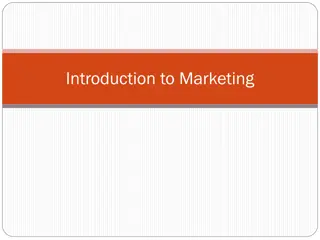Relationship Portfolios and Key Account Management in B2B Marketing
Explore the management of customer relationships, strategic options, and customer classification in business-to-business marketing. Learn how to assess risks and returns, strategic actions for relationship development, and criteria for classifying customers based on sales, profits, cost savings, and relationship age.
Download Presentation

Please find below an Image/Link to download the presentation.
The content on the website is provided AS IS for your information and personal use only. It may not be sold, licensed, or shared on other websites without obtaining consent from the author.If you encounter any issues during the download, it is possible that the publisher has removed the file from their server.
You are allowed to download the files provided on this website for personal or commercial use, subject to the condition that they are used lawfully. All files are the property of their respective owners.
The content on the website is provided AS IS for your information and personal use only. It may not be sold, licensed, or shared on other websites without obtaining consent from the author.
E N D
Presentation Transcript
Business to Business Business to Business Marketing Marketing Chapter 9 Relationship Portfolios and Key Account Management
Portfolio management of customer Portfolio management of customer relationships relationships APPLICABLE BECAUSE RELATIONSHIPS Constitute sources of risk and return Vary in the type of risk they constitute Vary in the level of return they bring Vary in the time horizon over which they provide that return
Table 9.1 Typical strategic options for a relationship Option Actions Build Build a relationship further for growth, investing where necessary to achieve this growth Maintain Maintain the current levels of management effort in a relationship in order to reap the benefits from the relationship now through large volumes, high profits or a greater share of the customer s purchases Harvest Harvest the value in the relationship by taking the current monetary value it brings while at the same time beginning to reduce the cost of servicing the relationship over time Reduce Reduce in the immediate future the level of management commitment to a relationship because the returns are diminishing with little prospect of reversal
Two Two- -way customer classification way customer classification Always-a-share customers Driven by price Make decisions about supply on the basis of the best deals in the market Happy to switch for a better deal OR Lost-for-good customers Want greater stability Will often subordinate price to other considerations o For example: continuity of supply, levels of product quality or a shared market view with their suppliers
More easily observed classification criteria More easily observed classification criteria Sales Profits Cost savings Relationship age
Figure 9.1: Depicting customers in terms of the prices achieved and the cost to service their accounts (adapted from Shapiro et al., 1987) (adapted from Shapiro et al., 1987)
Less easily observed classification criteria Less easily observed classification criteria Replaceability Criticality o Critically important products or processes Shared vision o Interest commonality Source of learning Supplier s share of customer s purchases Short term advantage taking
Relationship lifecycle variables Relationship lifecycle variables The experience of dealing with each other The uncertainty associated with working with each other The distance between the parties, incorporating social, geographical, time, cultural and technological manifestations The commitment the parties make to each other The specific adaptations they make to what they do and how they do it that brings them closer to the counterpart
Reasons for adopting KAM Reasons for adopting KAM 1. Increase market share (38% of respondents mentioned) 2. A change in business strategy (34%) 3. Allow increased customization of the product/service (26%) 4. Improve relationships with customers (26%) 5. Marketplace pressures (21%) 6. To become more attractive to large clients (20%) (Boles et al., 1999)
Criteria for assigning KAM status Criteria for assigning KAM status 1. Volume of potential business (92% of respondents mentioned) 2. Volume of past sales (78%) 3. Competitors actions (61%) 4. Size of customers (55%) 5. Industry of customers (48%) 6. Management discretion (29%) (Boles et al., 1999)
Key success factors in KAM Key success factors in KAM Knowledge and understanding of the key account customer s business Proper implementation and understanding of the KA program Commitment to the KA program the key account manager has a key role in bringing about commitment Suitability of the KAM suppliers highlighted the KAM s skills, ability and competence customers highlighted the importance of integrity, interpersonal skills, and sensitivity to the customer Trust (Abratt & Kelly, 2002)






















